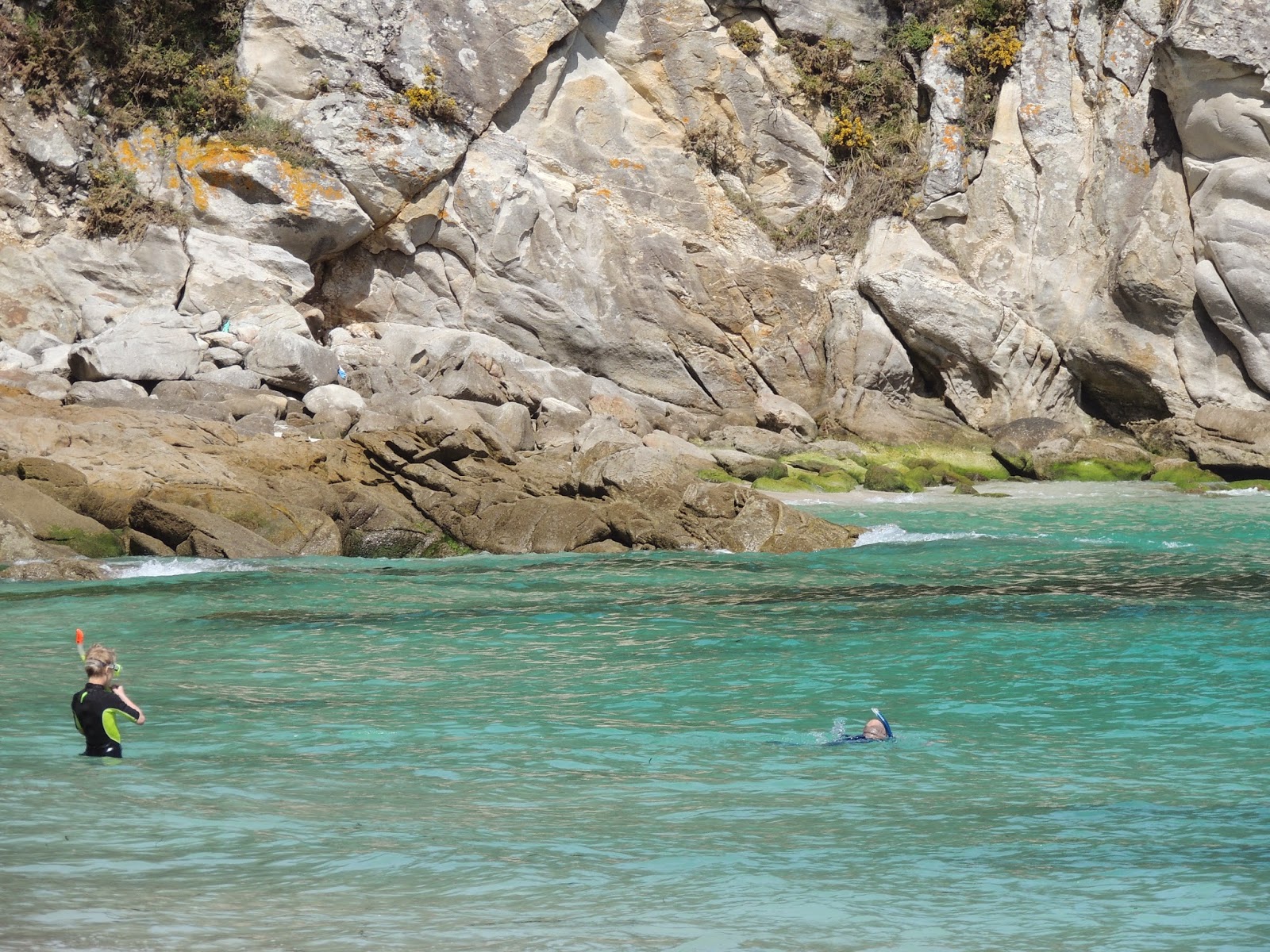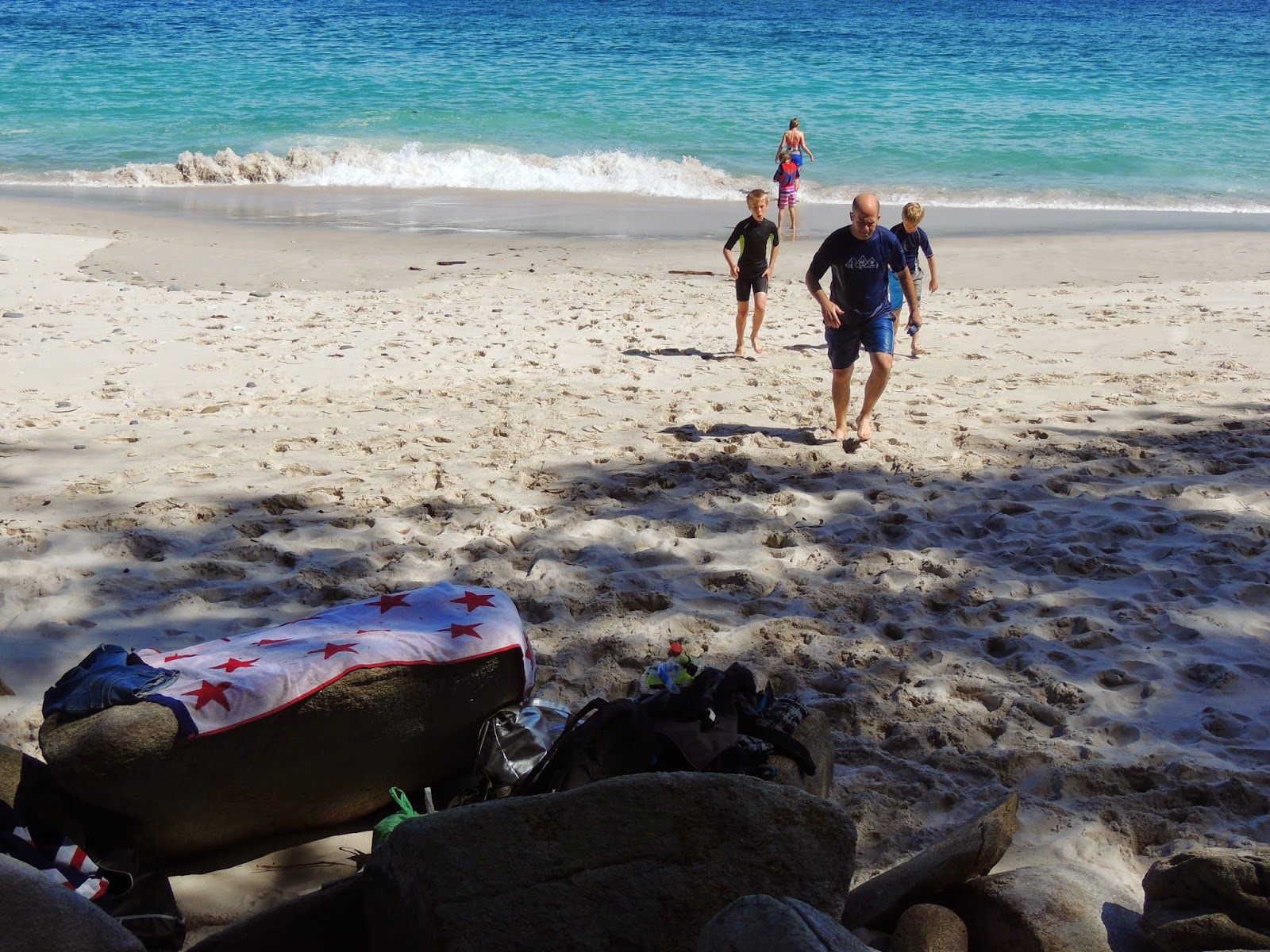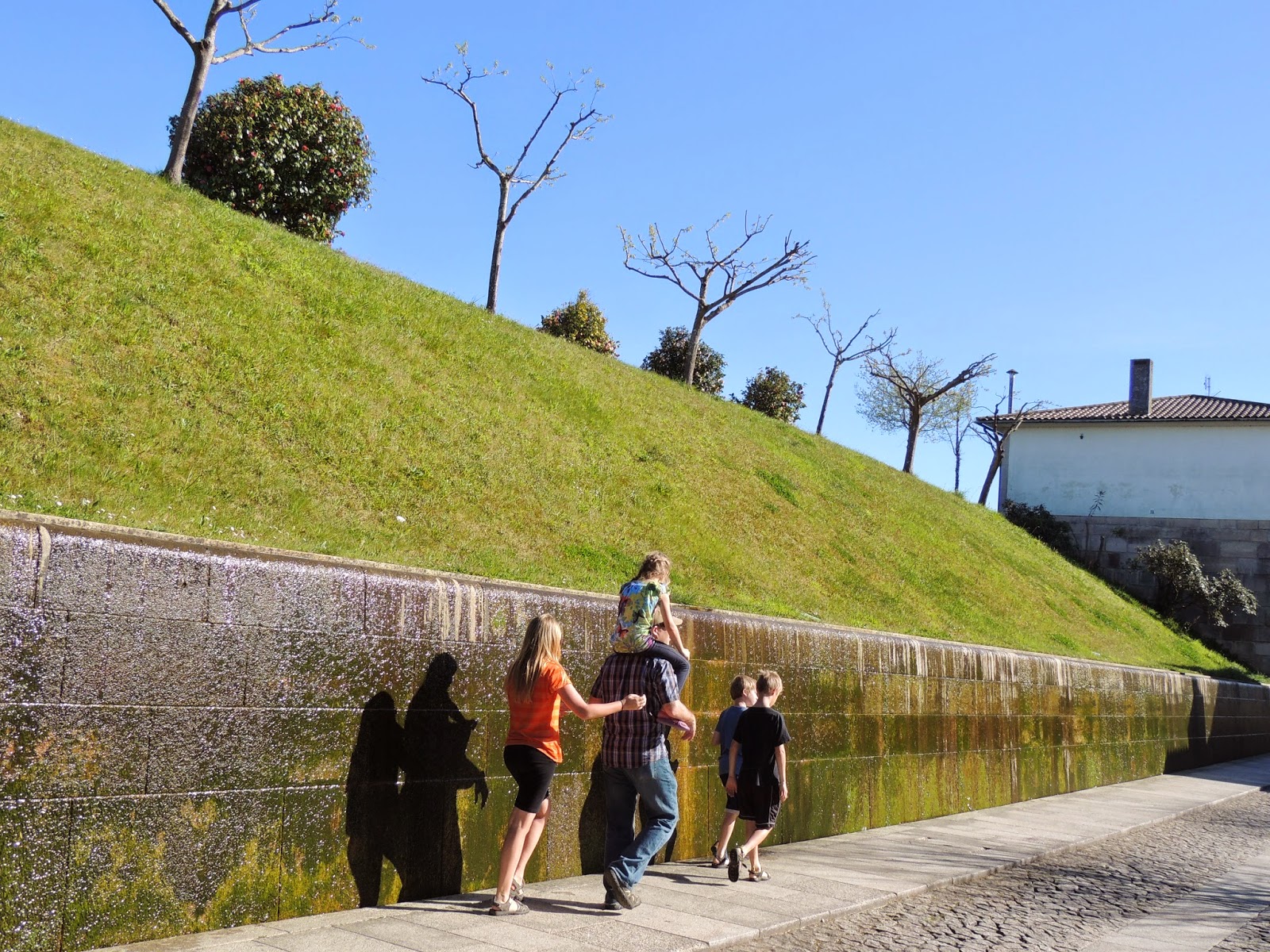For Spring Break we traveled to northern Portugal and the western coast of Spain.
Day 1- Valença, Portugal
 We arrived in the afternoon of the first day which gave us a few hours to explore. We began with the star-shaped Portuguese fortress which stands guard over the Minho river that divides Valença, Portugal and Tui, Spain.
We arrived in the afternoon of the first day which gave us a few hours to explore. We began with the star-shaped Portuguese fortress which stands guard over the Minho river that divides Valença, Portugal and Tui, Spain.  | ||
Believe me, these two were quite thrilled to explore another old walled city.
|

The city of Valença is known for it's linen. Bedding, towels, curtains etc. were being sold everywhere.
On the left is a "water wall"? It was as slimy as it looks. The weather couldn't have been more perfect on this day and throughout our entire vacation.
 |
| This is one of the city's many old churches. They were all very small, but as usual no expense was spared. Morgan and Mason are looking in from the doorway. |
The thickness of the defensive walls seemed a bit extreme.
This was taken outside the gate above and between the inner and outer walls.
 |
| Here we found Kaiya's and Mason's mini-me's. |

The first known walls of this fortress were built in the 13th century.

Some of the old cannons are still aimed at Spain as a reminder of their true past. This one is aimed at the town of Tui, Spain, which is where we go next.
Tui, Spain
Our destination was the Romanesque/ Gothic cathedral at the center of the town. The town of Tui suffered repeated attacks by vikings coming up the Minho River.As expected, Tui was no different than any other old Spanish town: narrow streets, rock buildings, cobblestone roads,

...and depressing statues of Christ on crosses. However; this statue was unusually cute and a little smaller than Kamree.
 |
| We finally made it to the 11th-13th century cathedral at the top of the hill. And as you can see, Kamree found it cartwheel worthy! |
 |
| On our way back to the car we walked through a carnival, and of course the kids begged us to let them try this out. |
 |
| We had nearly as much fun as they did by just watching them. |
 |
| Morgan had big plans to do all kinds of flips on this, but the best he could do was hang-out on this wire. |
I don't know about them, but we were well ready for it to be over by the time they were unhooked.
Casa Da Eira
 | |||
| We stayed in a central location at an amazing B&B for the 3 nights of our vacation. It was in an updated monastery from the 1700's. |
 |
| The older couple that ran this place were the sweetest people. We had a difficult time communicating with them since they only spoke a little Spanish and very little English. |
DAY 2
Vigo
Castro Fortress of Vigo
 |
| This fortress was constructed in 1665 during a war (1640-1668) with Portugal. It was built to protect the city from the continuous attacks coming from the British navy allies of Portugal. |
 |
| They also had some interesting trees such as this one that was mostly all roots. |
 |
| And this one that was mostly branches. |
O Castro De Vigo
The Celtic tribes had heavily
settled the area by the 4th century B.C., and lived in 'Castroes', "circular fortified
settlements of several buildings surrounded by a defensive ditch, normally situated
on hilltops". Current datings indicate that this Castro was inhabited for a period of 600 years.
Only a very small part of this old settlement has been excavated, but the size of this settlement is said to have covered an extensive area of this large hill.
Islas Cies
 |
| The ferry ride lasted around 40 minutes... |
 |
| and the views were stunning. |
 |
| In February 2007 the British newspaper "The Guardian" chose the Rodas Beach, on these islands(pictured on the right) as "the best beach in the world." |

This is the middle island looking to the northern Island with the Rodas beach connecting the two.
In the beginning, we headed the opposite way of the crowd to try to find a more private beach.
 |
| The kids wasted no time testing out the water. |
 |
| Although the water was chilly, the weather was perfect. |
 |
| Brent and Morgan braved the water in search of fish. |
 |
| These sly seagulls were just waiting for us to put our guard down. Apparently the world's largest seagull colony lives here. |

We had the pleasure of seeing the seagulls in action when they took off with our precious bag of goldfish left on the star towel we were using as a tablecloth for our lunch. We had all just walked down to the beach when we heard a guy yelling "comida". I turned to see a seagull flying through the air down the beach with our Ziploc baggie of Goldfish. We chased it down as it was just getting to the shoreline and it dropped the bag in the water as several seagulls dove for the bag. I chased them away just in time and was so relieved that the bag was still zipped closed. Too bad no one was filming it. Goldfish are priceless here since we can not get anything similar (thanks Rachelle).
This is the famous Rodas beach. It borders the other side of the Lagoon and connects the two northern islands when it is not washed out during high tide. We decided to explore the far end of this beach.
Morgan jumping into the very deep (2ft) water.
Actually that looks more like 2 inches of water.
 |
| I was afraid 4 hours would be too much time on these small islands, but we could have spent a lot more time here, they were beautiful and we still had much more area to explore. |
 |
| The kids weren't happy because we were leaving the island, but that they had gotten the VIP seats. |
Baiona and the Castelo de Monterreal |
We luckily were able to witness this Easter Procession. It would not have been Easter here had we not seen one. Baiona's population of just over 11,000 rises to around 50,000 in the summer, if you include tourists. Other than tourism, the major economic activities revolve around fishing.
 |
| After finding parking and a place to eat dinner it was nearly too dark to check this out but we did our best. |

As we were ascending the walls there was a warning sign stating that the walls were not up to code and to proceed with caution. We were grateful for the full moon light.
 |
| We all safely made it around the walls and back to the car. The Cies Islas are seen here in the Vigo Bay. |
DAY 3- A Guarda, Spain and Porto, Portugal
 |
| We began this day driving along the Minho River to the coast to see an old Celtic village above A Guarda, Spain with alleged spectacular views. |
These are the Celtic ruins of Castro de Santa Tegra (Santa Tecla), high on Mount Santa Tegra, overlooking the Minho River on this side and the Atlantic Ocean on the western side.
 This ancient Celtic settlement has hundreds of round stone-walled
dwellings, dating from at least the 2nd to 1st centuries BC.
This ancient Celtic settlement has hundreds of round stone-walled
dwellings, dating from at least the 2nd to 1st centuries BC.
This village was re-discovered in 1913, with the last excavation in 1988, yet still only part of the ruins have been uncovered. Houses, stores, workshops, yards, granaries, and even rainwater ditches and tanks have been excavated. The population may have been as many as 3000 to 5000 people.
 | ||||
| This is much of what has been excavated with the road being constructed right through the center of it. |
 |
| We found one of the larger homes and let the kids choose their own rooms. |
 We then headed farther up the mountain along an old Christian pilgrimage road lined with crosses to....
We then headed farther up the mountain along an old Christian pilgrimage road lined with crosses to......an old hermitage church (this was not the church), museum and look-out at the summit.
 | ||||||
From the summit you can see the mouth of the Minho River, the Atlantic Ocean and south to Portugal.
|
It seemingly went forever in both directions. We briefly pulled over here to talk to some LDS missionaries passing by.
We spent an hour or so at this beach to satisfy the kids on our drive to Porto.
 |
| We ate some Portuguese food for dinner in the food court of the shopping mall (where we seem to have the best luck) and found the sinks in the restrooms quite fascinating. |
Porto, Portugal
 |
| The main attraction of Porto is along the Douro river that divides the town. We quickly noticed several people on a bridge high above us and debated if that vantage point was worth the climb. |
After numerous steps up we made it to the top and just before the sun had set.
 |
| This is on the east side of the bridge. Our kids argued unsuccessfully to let them ride the train up this track to save time and energy. |

This is the beautifully, colourful Porto.

Porto has been referred to as the origin of the name "Portugal"
Finally some "cool" graffiti.
Last Day- Drive Home
This was an old Monastery near the B&B. We were hoping we could tour it but it was not open to the public while we were there.
The hosts at the B&B suggested we go to this huge park along the Minho river just before the freeway.

After just a few minutes at this endless toddler park, the kids were bored so we headed home.
Puebla de Sanabria

We spotted this town on our way to Portugal at the beginning of our vacation and planned to check it out on our way home.
This castle, sometimes referred to as the "Counts of Benanvente" was built in the 15th Century.
 |
| The castle-fortress, also known as the castle of Puebla de Sanabria stands more than 900 meters, above the Tera River Valley |
These three monkeys nearly fell to their deaths off this wall.
Castle of Urueña, Spain
While driving home we could see that there was possibly castle walls on that hill on our left so we pulled off the highway to check it out.The Church of San Andrés in Villardefrades
 |
| At the exit was "Villardefrades" a small town with just 200 inhabitants on the right of the freeway. We stopped momentarily at this old cathedral. |
 |
It is sadly one of the few old cathedrals we've seen that hasn't been restored, yet it's beauty is still evident.Urueña, Spain |
 The closer we got, the more certain we were that there were castle walls. As we got to the top of the hill we were surprised to see many people and an entire village.
The closer we got, the more certain we were that there were castle walls. As we got to the top of the hill we were surprised to see many people and an entire village. |
| Inside the walls. |

Outside the walls. Kamree took control of our camera nearly the entire time we were here. She got some great pictures of the kids, the walls, cats, stairs, shadows etc.
 |
| We felt as if we had stepped back in time being in this quaint medieval village. |
The walls date around the 12th-13th century.
The 13th century castle is in the process of being restored. It has housed the village cemetery for many years after housing many important figures. It once imprisoned a Portuguese princess who later married a local Spaniard.
We left not the way we entered which was a much better road. The view was also much better of the castle walls.
Ermita de Nuestra Señora de la Anunciada
 |
| Below the castle is this 11th century church with several of it's doors and windows filled in. |
On our way home we watched the moon move in and out of the Madrid skyline. The quality of the photo wasn't great since it was taken from the opposite side of the freeway, the far side of the car and zoomed in all the way.








































No comments:
Post a Comment